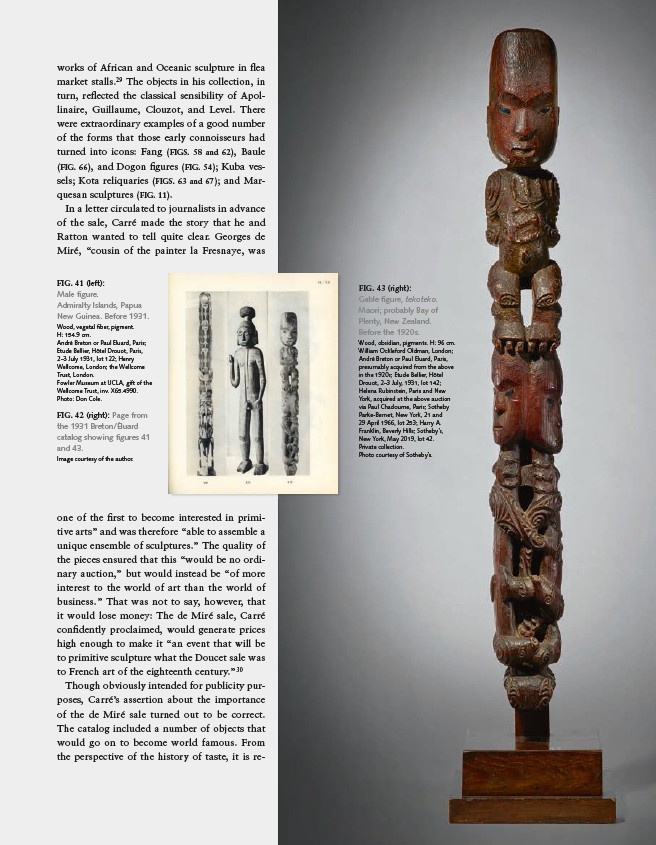
121
FIG. 41 (left):
Male fi gure.
Admiralty Islands, Papua
New Guinea. Before 1931.
Wood, vegetal fi ber, pigment.
H: 154.9 cm.
André Breton or Paul Éluard, Paris;
Étude Bellier, Hôtel Drouot, Paris,
2–3 July 1931, lot 122; Henry
Wellcome, London; the Wellcome
Trust, London.
Fowler Museum at UCLA, gift of the
Wellcome Trust, inv. X65.4990.
Photo: Don Cole.
FIG. 42 (right): Page from
the 1931 Breton/Éluard
catalog showing fi gures 41
and 43.
Image courtesy of the author.
FIG. 43 (right):
Gable fi gure, tekoteko.
Maori; probably Bay of
Plenty, New Zealand.
Before the 1920s.
Wood, obsidian, pigments. H: 96 cm.
William Ockleford Oldman, London;
André Breton or Paul Éluard, Paris,
presumably acquired from the above
in the 1920s; Étude Bellier, Hôtel
Drouot, 2–3 July, 1931, lot 142;
Helena Rubinstein, Paris and New
York, acquired at the above auction
via Paul Chadourne, Paris; Sotheby
Parke-Bernet, New York, 21 and
29 April 1966, lot 253; Harry A.
Franklin, Beverly Hills; Sotheby’s,
New York, May 2019, lot 42.
Private collection.
Photo courtesy of Sotheby’s.
works of African and Oceanic sculpture in fl ea
market stalls.29 The objects in his collection, in
turn, refl ected the classical sensibility of Apollinaire,
Guillaume, Clouzot, and Level. There
were extraordinary examples of a good number
of the forms that those early connoisseurs had
turned into icons: Fang (FIGS. 58 and 62), Baule
(FIG. 66), and Dogon fi gures (FIG. 54); Kuba vessels;
Kota reliquaries (FIGS. 63 and 67); and Marquesan
sculptures (FIG. 11).
In a letter circulated to journalists in advance
of the sale, Carré made the story that he and
Ratton wanted to tell quite clear. Georges de
Miré, “cousin of the painter la Fresnaye, was
one of the fi rst to become interested in primitive
arts” and was therefore “able to assemble a
unique ensemble of sculptures.” The quality of
the pieces ensured that this “would be no ordinary
auction,” but would instead be “of more
interest to the world of art than the world of
business.” That was not to say, however, that
it would lose money: The de Miré sale, Carré
confi dently proclaimed, would generate prices
high enough to make it “an event that will be
to primitive sculpture what the Doucet sale was
to French art of the eighteenth century.”30
Though obviously intended for publicity purposes,
Carré’s assertion about the importance
of the de Miré sale turned out to be correct.
The catalog included a number of objects that
would go on to become world famous. From
the perspective of the history of taste, it is re-